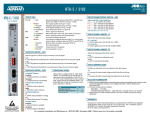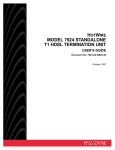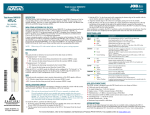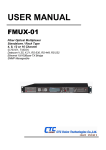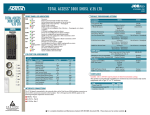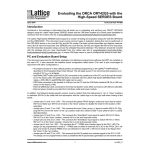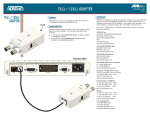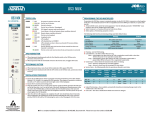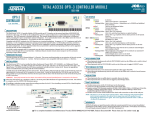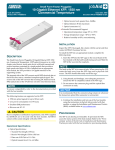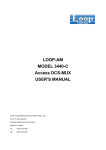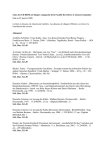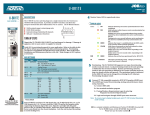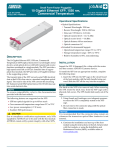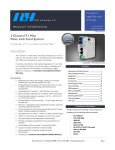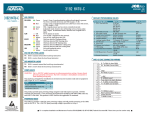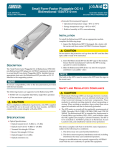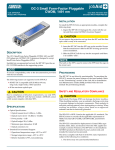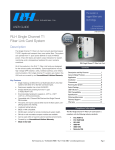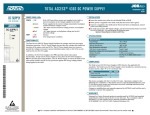Download ADTRAN DDM+ HTU-C M User's Manual
Transcript
JOBAID DDM+ HTU-CM DDM+ HTU-CM LED STATUS HTU-R Options Display (“VIEW”) ● GREEN Synchronization ✷ FLASHING ES, SES or BPV detected ● YELLOW Loopbacks active ✷ FLASHING In-band loopbacks armed ● RED Alarm on any HTU-C loops, HRE loops, DSX or DS1 interface ✷ FLASHING Signal Quality of 0 or No Sync on at least one loop STATUS CLEI:T1L3BWBA_ _ HTU-C 1246003L8 61246003L8-22B 0006 4 CHARACTER DISPLAY (FCD) OPERATION MODE UP = MODE CENTER = OFF DOWN = SELECT SELECT MODE Message Description Settings Default TXLV PRM DS1 Transmit Level Performance Reporting Messages 0 dB, -15 dB NPRM, SPRM, None 0 dB None Parameter Settings Display (“PROV”) Message Description Settings Default LBO CODE FRMG NELB NLBK LBTO CLOS LTCH SPWR SALM DSX-1 Transmit Level Line Code DSX-1 Framing New England 1:6 loopback NIU Loopback Loopback Timeout Customer Loss Response Latching Loopback Span Power Shelf Alarm 0, 133, 266, 399, 533 AMI, B8ZS AUTO, ESF, SF, UNF, FFFC EN, DIS EN, DIS 0, 120 AIS, LPBK, CDI T1, FT1 ON, OFF EN, DIS 0 B8ZS ESF DIS EN 120 AIS T1 ON EN Loopback Options Display (“LPBK”) FCD Modes SELECT STATUS R S 2 3 2 Mode Display Status STAT Display Off View Provisioning Default Loopback Blank VIEW PROV DFLT LPBK HDSL loop margin, displays 1=xx or 2=xx, where xx=loop margin 0-2 marginal signal quality, 3-20 acceptable signal quality Result after five minutes of no activity View current parameters without changing Set configuration options Sets all factory defaults Select and execute HDSL circuit loopbacks Status/Alarm Display (“STAT”) Select Loopback State Loopback Description LPBK HTUC Net CST NONE BLB NET CST NONE NET CST NONE NET CST NONE Network loopback at HTU-C Customer loopback at HTU-C No active loopback Bilateral loopback at HTU-R Network loopback at HTU-R Customer loopback at HTU-R No active loopback Network loopback at HRE1 Customer loopback at HRE1 No active loopback Network loopback at HRE2 Customer loopback at HRE2 No active loopback HTUR HRE1 HRE2 Message Condition HER1 HER2 LERR RERR LBPV RBPV LOS1 LOS2 LLOS RLOS ARM C A U T I O N ! Function Mode CRC error detected on HDSL Loop 1 CRC error detected on HDSL Loop 2 Frame bit error (SF Mode) or CRC error (ESF Mode) detected locally at DSX-1 of the HTU-C Frame bit error (SF Mode) or CRC error (ESF Mode) detected locally at DS-1 of the HTU-C Bipolar Violation (BPV) detected locally at DSX-1 of the HTU-C BPV detected locally at DS-1 of the HTU-R No synchronization of HTU-C and HTU-R on Loop 1 No synchronization of HTU-C and HTU-R on Loop 2 DSX signal is absent from the network interface or is of a format which does not match the provisioning of the HDSL circuit DS1 signal is absent from the network interface or is of a format which does not match the provisioning of the HDSL circuit The loopback arming sequence has been detected WARRANTY Carrier Network products manufactured by ADTRAN and supplied under Buyer’s order for use in the U.S. is ten (10) years. For a complete copy of ADTRAN’s U.S. Carrier Network Equipment Warranty: (877) 457-5007, Document 414. COMPLIANCE CODES This product is intended for installation in restricted access locations only and in equipment with a Type “B” or “E” installation code. Input current at maximum load is 0.7 A at –48 VDC. Maximum output at over current condition is 165 mA at –190 VDC. CODE IN OUT Installation Code (IC) A – Telecommunication Code (TC) – X Power Code (PC) F C SUBJECT TO ELECTROSTATIC DAMAGE OR DECREASE IN RELIABILITY. HANDLING PRECAUTIONS REQUIRED. ■ For a complete Installation and Maintenance Practice: (877) 457-5007, Document #455. Please have your fax number available. ■ PRICING AND AVAILABILITY 800.827.0807 TECHNICAL SUPPORT 800.923.8726 RETURN FOR REPAIR 256.963.8722 www.adtran.com TURN-UP & TROUBLESHOOTING GUIDE INSERTION LOSS MEASUREMENTS HTU-C VMDF HRE 1 HRE2 HTU-R HTU-C Frequency (kHz) HTU-R 1246003L8 Maximum Loss Data (dB) 1246026L4 H D S L LP1 LP2 DS1 ALM ESF (YEL) SF (GRN) B8ZS AMI LLB RLB (YEL) (YEL) (GRN) (GRN) MODE LOC 10000 50000 100000 150000 196000 200000 250000 325000 15.00 25.50 30.00 32.75 35.00 35.25 37.50 42.00 LBK SELECT REM STATUS B R G R S 2 3 2 A t-t Voltage Circuit with 2 HREs (open at frame) 185 - 190 Circuit with 0 or 1 HRE (open at frame) 145 - 150 HTU-C / HTU-R 145 - 150 HTU-C / HRE1 / HTU-R 130 - 135 HTU-C / HRE 2 / HTU-R 185 - 190 NOTE: If your TIMs is unable to transmit 200 kHz tone, set the TIMs to one of the frequencies shown above and compare the received signal to the maximum loss at that frequency. TX M O N RX R S 2 3 2 B t-t Voltage N/A N/A 145 - 150 110 - 135 160 - 185 C t-t Voltage N/A N/A 130 - 145 110 - 135 160 - 185 D t-t Voltage N/A N/A N/A N/A 140 - 185 E t-t Voltage N/A N/A N/A N/A 140 - 185 F t-t Voltage N/A N/A 125 - 130 100 - 135 130 - 185 NOTE: All measurements taken with HTU-C installed. With the HTU-C unseated or with protector removed at VMDF, t-r resistance will be cable resistance plus 3 ohms (for either HRE or HTU-R). wiring problem or a B8ZS/AMI mismatch between the HTU-R and the customer equipment. This is not an indication of problems on the HDSL loops. Turn-up Guide 1. Set option switches according to specific circuit design 2. Install HTU-C and HTU-R 3. The status LED should be green, no alarm indications on the four-character display (FCD) and synchronization has occurred (a) HTU-C will display LLOS if not connected to network (no DSX present; LED will be solid red). (b) HTU-R will have red ALM LED if customer not connected. LP1, LP2, line coding (B8ZS or AMI) and framing (ESF or SF) (if not UNFR) LEDs should be illuminated. 4. If Status LED is green: (a) Verify that the signal quality is the same on each loop. Ensure signal quality indicators do not fluctuate. (b) Verify that the loop loss is within design limits. If there is a difference of more than 1 dB between the two loops, a problem exists with the cable pairs. (c) If errors occur, use the Current System Status and Performance History screens to determine where they are occuring. See Troubleshooting Guide. 5. If everything checks out, proceed with BERT testing. Troubleshooting Guide The HTU-C status LED is flashing green and the FCD indicates "LERR," "HER1," "HER2" or "LBPV" but no errors are indicated by the HTU-R ■ A BPV, Frame error (SF) or CRC error (ESF) has been detected at the DSX-1 interface. Possible network or wiring problem between the HTU-C and the DSX. This is not an indication of problems on the HDSL loops. The HTU-R DS1 LED is Flashing, but no Errors are Indicated by the HTU-C ■ A BPV, Frame Error (SF) or CRC Error (ESF) has been detected at the DS1 interface. This indicates a The HTU-R has Power, but LP1 and LP2 LEDs are Dark. The Unit cannot Sync with the HTU-C ■ Simplex power for powering the HTU-R can be passed over cable pairs that contain load coils or that are too long for HDSL synchronization. Using a TIMS, verify the circuit is within design limits. ■ The HTU-R will power up as long as there is at least one good conductor on each loop. To test, remove the protector plug at the MDF and measure t-r resistance to the HTU-R on both loops. The HTU-R will place a 3 ohm short between t-r on both loops. An extremely high impedance indicates an open conductor. An extremely low reading on one loop may indicate a t-r short in the field. In the field, measure t-t and t-r voltage with the HTU-C installed and compare to the chart above. If these voltages are not present, open pairs or mis-wiring is indicated. As with other circuits, standard resistance measurements between each conductor and ground should also be used to test for a grounded conductor. ■ A high resistance open which degrades to the point that it causes the circuit to lose sync can be “resealed” by reseating the HTU-C. Test the cable pairs before reseating the HTU-C. Running Excessive Errors on the Loop ■ Measure t-r resistance as described above. If the pairs are unbalanced by more than 4 ohms, or a measurement varies a great deal, this could indicate a high resistance open or an intermittent fault on the loop with the higher measurement. A TDR is typically required to locate this splice for repair. ■ Excessively long bridged taps can also cause errors. Check the records and/or use a TDR to verify the location and length of bridged taps. ■ Using ADTRAN’s “Performance History” screen, it is often possible to see that many more errors are being received on a particular loop or at a particular unit. The fault will typically be very close to the unit receiving the most errors. No Power at the HTU-R ■ This could be caused by a loop with two open conductors. Measure t-r resistance from the MDF to the HTU-R or use the voltage chart to see which pair is open.


